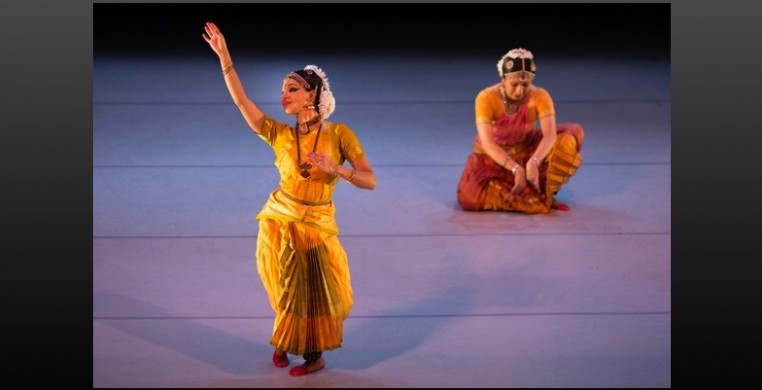The below piece is part of Critical Context, a paid writing residency created in partnership with the Harris Theater. The initiative engages past SCD Critical Dance Writing Fellows in a three- to six-month residency in mentorship, research, and deep exploration of Harris Theater Presents dance programming.
By supporting writers in building their bodies of work — prioritizing writers of color and those with backgrounds in underrepresented dance forms — Critical Context aims to promote equity in the dance writing field, expand and deepen Harris Theater communications through multiple lenses, and enhance audience access to and understanding of the art form.
The first two writers selected for Critical Context are D’onminique Boyd-Riley and Tristan Bruns. Tristan's work with Ragamala Dance Company is featured here.
Bharatanatyam is more widely practiced and performed than any of the eight classical dance forms of India; but for most of human history, if you wanted to see any of the classical Indian dances, you had no choice but to visit the regions of their origin. But wait! Before you buy a (very expensive) plane ticket, there is good news for Chicagoans: Ragamala Dance Company will be returning for a brief engagement that promises to bring the wonders of traditional Bharatanatyam coupled with a personal story of family and faith as experienced by immigrants of the diaspora.
“Fires of Varanasi: Dance of the Eternal Pilgrim” is a new work by Ragamala Dance Company to be performed at the Harris Theater for Music and Dance for one night only on December 2. The program was conceived, choreographed and performed by mother/daughter co-directors Ranee and Aparna Ramaswamy, accompanied by eight other dancers, with lighting and scenic design by French designer Willy Cessa and original musical compositions by Prema Ramamurthy, Ranee Ramaswamy, S. Sakthivel Muruganantham and Lalit Subramanian. Audiences can expect a combination of contemplative choreography based on ancient Hindu ritual balanced by virtuosic and engaging solo performances.
I remember my first time experiencing classical Indian dance over a decade ago during a tour of the “Jazz India Suites” by tap dancer Jason Samuels Smith and master dancer Chitresh Das, who performs Kathak, a form that shares its ancient origins with Bharatanatyam. I was captivated by Das’ ability to maintain intricate polyrhythms, not just in his feet, but in every part of his body—hands, head, neck, eyes and knees. Not only was I in rhythm heaven, but Das, at the time in his sixties, easily kept pace and at times even outdoing Smith, who was easily half his age, both in physical expression and rhythmic complexity—and this was done in bare feet versus metal shoes! Shortly after this tour a wave of tap dancers, myself included, fell in love with Kathak, and later Bharatanatyam, for its ability to make the dancer simultaneously a physical performer, a storyteller and a musician.
The story being told in “Fires of Varanasi: Dance of the Eternal Pilgrim” is no mere narrative, but more like a grand epic of the utmost spiritual significance that dates back to time immemorial. The “Fires” in the title refer to the funeral pyres that burn throughout the night in the sacred city of Varanasi in Northern India. The “Eternal Pilgrim” in the subtitle represents the millions (yes, millions!) of Hindus who make pilgrimage from all over the world to die in the holy city, then to be cremated in those pyres—which burn nonstop—then to have their ashes scattered in the Ganges River. With this final pious ritual, the recently deceased increase their chances of achieving a better next life through reincarnation, or possibly even ending their personal cycle of death and rebirth by achieving moksha, thus becoming one with the Supreme Being.
The meaning of this production is doubly personal for its creators. When Ranee’s father passed away four years ago, his final wish was to have his ashes returned and spread at Varanasi. The experience left both Ranee and Aparna with an even deeper sense of spirituality, but also a sense of universalism and connectedness. “Fires of Varanasi” expands beyond Hinduism to “honor immigrant experiences of life and death in the diaspora.”
What makes this work even more personal is the Ramaswamys’ connection to an important Chicago cultural advocate and former president and CEO of the Harris Theater, Patricia Barretto, who passed away last year from breast cancer—in fact, Ragamala dedicated a previous performance of “Fires of Varanasi” at the Kennedy Center in Washington D.C. to Barretto. The Ramaswamys first met Barretto in 2018 and the former CEO is credited with being an instrumental force in getting Ragamala’s latest work to Chicago.
“Patricia was a unique presenter, perhaps the first South Asian woman in the role of CEO at a major arts institution. In our long careers in the US, this was our first experience working closely with a South Asian woman curator. She approached our work in a nuanced context and was eager to share it with her audiences—her enthusiasm was boundless and contagious.”
- Ranee and Aparna Ramaswamy
“Fires of Varanasi: Dance of the Eternal Pilgrim” is a celebration of life—of which death is a part—and the work embraces both the natural and the divine, drawing on upon the human penchant for spiritual solace and a longing to return to the familiar, to “home.” Death is hard to deal with no matter who you are or where you come from; and in this new work from The Ragamala Dance Company, audiences have an opportunity to explore one of humanities’ oldest traditions of coming to terms with the inevitable.
Ragamala Dance Company performs “Fires of Varanasi: Dance of the Eternal Pilgrim” Dec. 2, at the Harris Theater for Music and Dance, 205 E. Randolph St. Tickets are $35-$140 and available at harristheaterchicago.org or 312.334.7777. For more details, click the event page below.


